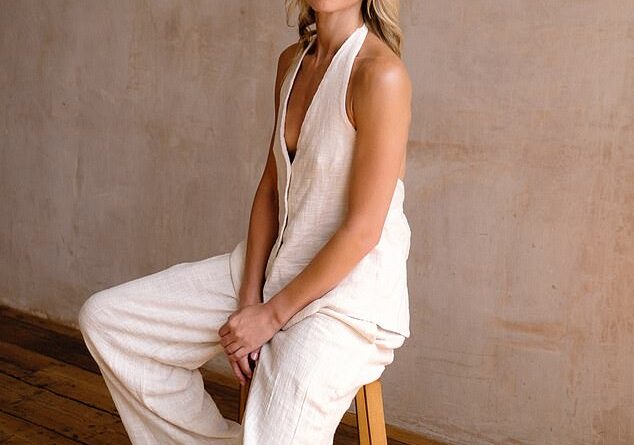Revealed: Five anti-aging “Neuroblast” Pilates moves for your body – AND your brain.
Have you ever stumbled upon a workout that is harder to follow than advanced math?
‘Everyone has been in a class – whether it’s Pilates or step aerobics or dance – where you get a little confused,’ says fitness instructor Gemma Folkard. ‘Don’t worry, it’s really good for you.’
Yes, the big bonus is that you work your brain as well as your body. That’s why Gemma, the founder of Shape Pilates, teaches what she calls ‘Neuroblast Pilates’, ensuring that her students strengthen their muscles and their minds.
He says: ‘Any movement based on rhythm, especially Pilates, where the composition requires you to remember and perform complex sequences of movements, can greatly improve your mental performance.
Gemma explains that her Neuroblast Pilates complex to sculpt the biceps and lower back, also challenges the brain. ‘You often need to interpret and adapt to the movements, and transition well from one movement to another. [known as flows] it requires quick thinking. Neuroblast Pilates is a truly effective way to connect mind and body.’

Fitness instructor, Gemma Folkard, explains that her Neuroblast Pilates complex to sculpt the biceps and lower back, also challenges the brain.
Meanwhile, the need to store complex information stimulates the brain’s memory centers, so if you use it regularly, Neuroblast Pilates can help improve short-term and long-term memory by strengthening nerve connections and even and create new ones.
And of course, physical activity has its own benefits. ‘You’re increasing blood flow to your brain,’ says Gemma, and you’re also improving balance, coordination, and spatial awareness. And unfortunately, he says it’s all work, no play. ‘It’s fun again.’
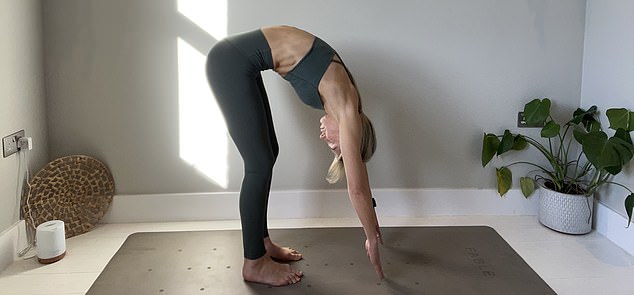
Gemma recommends putting the fingertips down, getting more oxygen to the brain while improving balance, coordination, and spatial awareness.
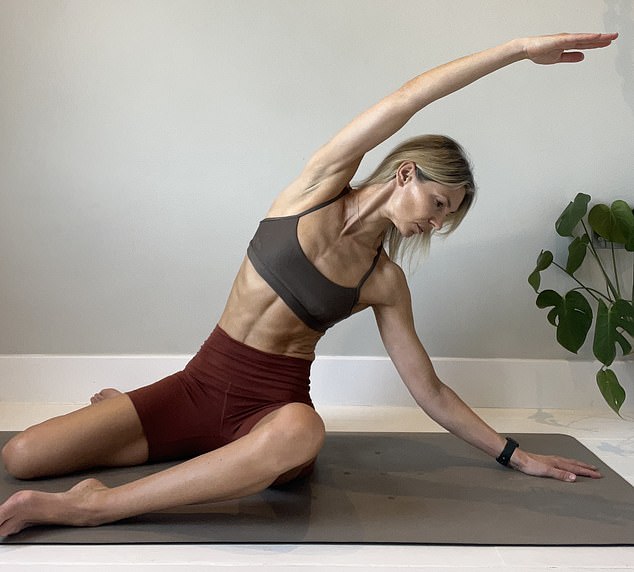
By using these movements, you are stimulating both sides of your brain, strengthening the nerves between them, thus building mental and physical resilience.
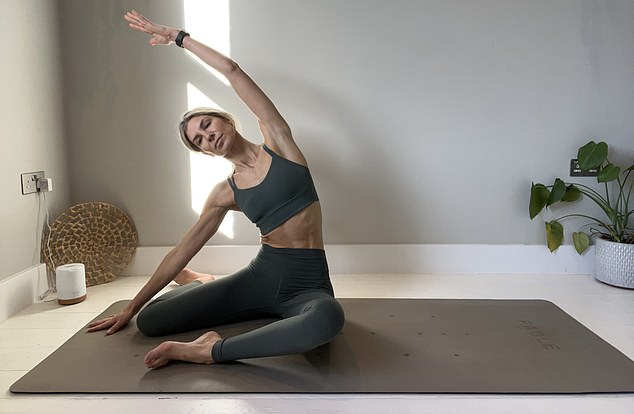
Mermaid Side Stretch: Sit on the floor with your right leg in front of you and your left leg out to the side. Bend your knees, with your right leg straight toward your torso and your left leg straight behind you.
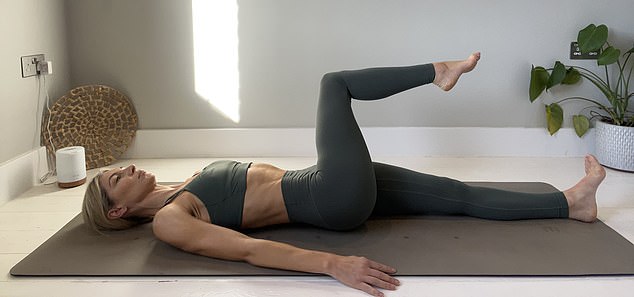
One leg circles: Lie on your back and lift your right knee. Slowly circle your thigh four times as if you are pulling a circle on the ceiling with your right knee. Switch legs and repeat
Below, Gemma reveals two of her Neuroblast Pilates flows – seamless transitions between movements – that will benefit your back, abs, abs and all-important brain cells.
The first flow
1. Supercharging your stability
Kneel on the mat, and rub your hands together, until you feel some warmth. Doing this increases foresight – your brain’s perception of the location of different parts of your body, which is important for proper coordination.
Collaboration and perspective are important in everyday life. Seemingly simple things, such as avoiding obstacles while walking down the street, require spatial awareness and become more difficult as we age. Using these skills can slow down cognitive decline and keep us feeling competent and youthful.
Then move to all fours, knees under your hips and the heels of your hands under your shoulders. No sagging torso is allowed. Extend your left arm and right leg – so your left arm is stretched out in front of you, touching the mat, and your right leg is pointed, toes touching the mat.
You are already working on the left and right sides of the brain. Slide both to the starting point, then exit, and enter. Your right arm works hard to stabilize you – keep your right elbow flexible.
2. To strengthen your stability
Start from an extended position as practiced in the previous movement, opposite leg and straight arm. Then raise an extended hand, and place the fingertips on the forehead – as if to say hello. Your shoulders should be square.
Then lift the opposite leg, and bend the knee, so that your thigh is horizontal, in line with your body, and your leg is pointing to the ceiling.
Then roll under your back, pull your head and elbow towards your knee – make a little ball – and stretch your arm and leg out. the knee is always bent. And repeat – on both sides. Loads of balancing going on here! This is good for the brain as balance requires it to process sensory information quickly and efficiently.
Activities that challenge balance stimulate different areas of the brain, including those responsible for motor control, coordination and sensory processing. This stimulation can improve overall cognitive function by keeping these areas of the brain active and engaged.
3. To challenge your thinking and connection
If that’s not enough for your brain (it isn’t) we have more to add. Extend your left arm and right leg. From here, lower your left hand to the hip, as the leg comes down.
Then lift your leg up, sweep your arm back so that it stretches out in front of you, then bend your arm and bring your hand to your forehead as if to salute, while bending the knee (on the right side , like your calf. and the leg is perpendicular.)
Then roll down, pull the elbow toward the knee, then lift, and extend. And walk again, find your flow. You’re working your abs, and focus and concentration work your brain!
Then roll down, pull the elbow toward the knee, then lift, and extend. And walk again, find your flow. You’re working your abs, and focus and concentration work your brain!
If that’s not enough for your brain (it isn’t) we have more to add. Extend your left arm and right leg. From here, lower your left hand to the hip, as the leg comes down. Then lift your leg up, sweep your arm back so that it stretches out in front of you, then bend your arm and bring your hand to your forehead as if to salute, while bending the knee (on the right side , like your calf. and the leg is perpendicular.) Then you roll under, pull the elbow to the knee, then lift, and extend.
And walk again, find your flow. You’re working your abs, and focus and concentration work your brain!
Then lift your leg up, sweep your arm back so that it stretches out in front of you, then bend your arm and bring your hand to your forehead as if to salute, while bending the knee (on the right side , like your calf. and the leg is perpendicular.)
Then roll down, pull the elbow toward the knee, then lift, and extend. And walk again, find your flow. You’re working your abs, and focus and concentration work your brain!
Second flow
4. Head rush!
To get more oxygen to the brain: we start this flow by standing on the left side of your yoga pose, feet parallel to your hips, arms folded in front of you.
Lift your right heel, and then – move to a wider side of the swing. When you are kneeling, that knee should be over your middle toe. Bend at the hips so that your back is at a 45-degree angle. Bend deeply to stretch your inner thigh.
Then return to your starting position. Clear, show up! Your left leg supports you. It is rooted to the ground like the good trunk of a solid tree. Can you feel the blood pumping? It’s so beautiful! And repeat on the other side.
5. Time for the flow of the cross system to work on both sides of the brain
This is useful because multimodal exercises involve moving the limbs across the midline of the body. These types of exercise engage the brain’s hemispheres and have many benefits for brain health.
These include everything from reducing mental stress due to distraction (aids for this concentration), working speed and the ability to move well in different directions.
Once you’ve developed the side part, we’ll introduce a cross style flow. Return to your starting position, and lift your right knee, so that your thigh is horizontal, and support that knee with your left hand.
Then we take the same leg behind us – point your right toes to the left – and press the right leg with your left hand. Then bring your right leg back to the starting position – and step sideways. Come back up, lift your right knee – and tap with your left hand.
Is it getting easier? You work the hips, glutes, and quads. You also stimulate both sides of your brain, strengthening the neural pathways between them, thus building mental and physical resilience.
Congratulations on completing your first Neuroblast Pilates workout – you’ve earned an A star!
* You can find out more from Gemma Folkard at: https://shape-pilates.com and https://apps.apple.com/gb/app/shape-pilates-london/id6535696127
#Revealed #antiaging #Neuroblast #Pilates #moves #body #brain
